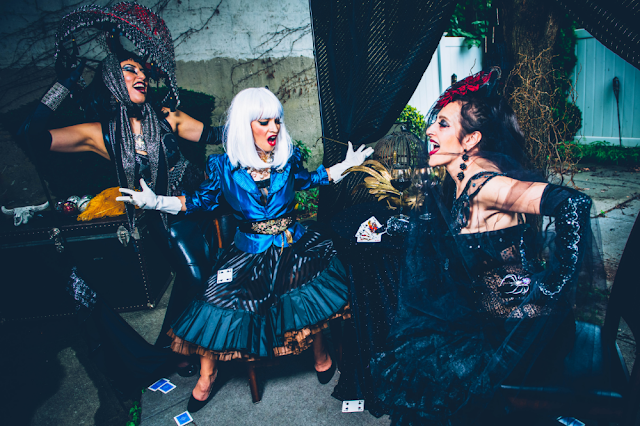An inspiring collaboration of a choreographer and a fashion designer blends different styles in exploration of the performance of gender.
An elegant lady winks at me from beneath a beaded lampshade worn as a hat. But before I can fully appreciate the intricate details of this human sculpture, I am pulled away by a bubbly blonde in a 50’s style dress. Right from the door the performers of Menagerie D’arte engage the audience members in their shenanigans, taking place in every corner of Teatro LATEA. I find myself in the company of two ladies winding musical boxes under the oriental canopy backstage. The next minute I am on stage taking a hula-hoop lesson. The hostess of the evening, Dalia Carella, the artistic director of DCDC (Dalia Carella Dance Collective), reads tarot by the bar. And in the green room, the dancers complain about each other, mostly in Italian, while generously pouring champagne to their guests.
 |
| photo courtesy DCDC |
The half-hour pre-show flies by in this carnival-like atmosphere. Once the lively interactive prelude is over, the audience members are asked to take their seats in a black box theater. From here, the show follows a rather conventional cabaret format. There are a over a dozen solos, duets and group numbers performed by nineteen dancers, brought together by Carella. This evening showcases both repertory works of the ensemble as well as new dances, many of them featuring the signature DCDC blend of traditional and contemporary choreography.
The kaleidoscope of world-dance fusion includes flamenco, salsa, and belly dance, among others. A lot of the numbers are choreographed by the performers themselves. Menagerie D’arte doesn’t shy away from pop-culture female archetypes like “exotic oriental beauty” or “dumb blond housewife” but gives them a dark and intriguing spin. The majority of the dancers are women and there is a strong emphasis on the variety of the female representations, something that Carella actively explores throughout her career. The show even ventures into the macabre territory of horror films by featuring two female werewolves and a ghost-like creature wearing a horrifying Japanese mask. This brief exploration of something completely unexpected when it comes to “performing femininity” is refreshing. Inclusion is inspiring in the context of the gender performance and, as shown by DCDC can be achieved effectively even in a family-friendly PG-13 format.
Thanks to the skilled and charismatic performers, as well as show-stopping costumes by Debbie D. Cartsos, there is a constant sense of surprise. There is equal collaboration between the choreographer, Carella, and the costume designer, Cartsos, who are both co-producers of the show. The understanding between the two is evident and reflected in each other’s artistic visions. Cartsos’ whimsical costumes mix iconic style elements and new inventions with the same daring playfulness that Carella and other members of her company combine different dance traditions. As an example, Kunoichi – The Japanese Spies includes belly dance moves, for which the kimono-inspired costumes are accommodating by exposing the dancer’s midriff. Another great example of the choreographer-designer collaboration is Le Jardin. In this dance, the manipulations with transforming dresses are the basis for the choreography of the entire piece.
Thanks to the skilled and charismatic performers, as well as show-stopping costumes by Debbie D. Cartsos, there is a constant sense of surprise. There is equal collaboration between the choreographer, Carella, and the costume designer, Cartsos, who are both co-producers of the show. The understanding between the two is evident and reflected in each other’s artistic visions. Cartsos’ whimsical costumes mix iconic style elements and new inventions with the same daring playfulness that Carella and other members of her company combine different dance traditions. As an example, Kunoichi – The Japanese Spies includes belly dance moves, for which the kimono-inspired costumes are accommodating by exposing the dancer’s midriff. Another great example of the choreographer-designer collaboration is Le Jardin. In this dance, the manipulations with transforming dresses are the basis for the choreography of the entire piece.
Unfortunately, the black box of Teatro LATEA isn’t the most fitting venue for the show; something like a more traditional cabaret with little tables or even a bar, would be helpful in creating the right atmosphere. As is, the theater is great for listening to the performers’ stories, but less efficient for immersing yourself in a fashion and dance fantasy. It was much easier to stretch my imagination in the make-believe cabaret of the pre-show. The virtual absence of any spatial design is compensated by audience engagement with interaction and activities. But as soon as the audience members are offered to take a seat in front of the proscenium, some of Menagerie D’arte’s magic disperses. The audience seemed less enthusiastic after sitting down and the transition from being a playmate to a mere observer made me feel abandoned.
The lovely performances and pre-show interactions could only benefit from more curating, as Menagerie D’arte lacks the coherence of a cabaret evening. In its current incarnation, it is more of a talent showcase striving to be more. Carella appears as a hostess but doesn’t fully exploit her role of the MC. The single vignette with her interacting with an audience member was a delight for people in the seats and the overly excited participant alike; it would be great to have more of these to help maintain the lively energy from the pre-show. There is a good proportion of fun and playful numbers with more somber ones. Menagerie D’arte biggest challenge is to figuring out how to balance the interactive elements with the more traditional presentations.
[This review was published on noproscenium.com on 12.6.18]
No comments:
Post a Comment